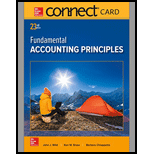
Concept explainers
Journal entries are used to record the transactions of an organization in a chronological order. Based on these journal entries, the amounts are posted to the relevant ledger accounts.
Accounting Rules for Journal Entries:
⮚ To increase balance of the account: Debit assets, expenses, losses and credit all liabilities, capital, revenue and gains.
⮚ To decrease balance of the account: Credit assets, expenses, losses and debit all liabilities, capital, revenue and gains.
To prepare: Journal entries.
Explanation of Solution
a.
The merchandise sold on credit:
| Date | Account Title and Explanation | Post ref. | Debit ($) |
Credit ($) |
| Accounts Receivables | 1,345,434 | |||
| Sales | 1,345,434 | |||
| (Record the credit sales) |
Table (1)
• Account receivable account is an asset account and it record an increase, hence it is debited.
• Sales account is a revenue account, it records an increase, and hence it is credited.
Cost of goods sold:
| Date | Account Title and Explanation | Post ref. | Debit ($) |
Credit ($) |
| Cost of Goods Sold | 975,000 | |||
| Merchandise Inventory | 975,000 | |||
| (Record cost of goods sold) |
Table (2)
• Cost of goods sold is an expense account, it records an increase, and hence it is debited.
• Merchandise inventory account is an asset account and it decreases, hence it is credited.
b.
Write off an uncollectible account:
| Date | Account Title and Explanation | Post ref. | Debit ($) |
Credit ($) |
| Allowance for Doubtful Accounts | 18,300 | |||
| Accounts Receivables | 18,300 | |||
| (Write off an uncollectible accounts) |
Table (3)
• Allowance for doubtful account is a contra asset account and it reduces the
• Account receivable account is an asset account and it record a decrease, hence it is credited.
c.
Payment received from debtor:
| Date | Account Title and Explanation | Post ref. | Debit ($) |
Credit ($) |
| Cash | 669,200 | |||
| Accounts Receivables | 669,200 | |||
| (Write off an uncollectible accounts) |
Table (4)
• Cash account is an asset account and it record an increase, hence it is debited.
• Account receivable account is an asset account and it record a decrease, hence it is credited.
d.
| Date | Account Title and Explanation | Post ref. | Debit ($) |
Credit ($) |
| 28,169 | ||||
| Accounts Receivables | 28,169 | |||
| (Write off an uncollectible accounts) |
Table (5)
• Bad debt expenses account is an expense account and it increases, hence it is debited.
• Account receivable account is an asset account and it record a decrease, hence it is credited.
e.
The merchandise sold on credit:
| Date | Account Title and Explanation | Post ref. | Debit ($) |
Credit ($) |
| Accounts Receivables | 1,525,634 | |||
| Sales | 1,525,634 | |||
| (Record the credit sales) |
Table (6)
• Account receivable account is an asset account and it record an increase, hence it is debited.
• Sales account is a revenue account, it records an increase, and hence it is credited.
Cost of goods sold:
| Date | Account Title and Explanation | Post ref. | Debit ($) |
Credit ($) |
| Cost of Goods Sold | 1,250,000 | |||
| Merchandise Inventory | 1,250,000 | |||
| (Record cost of goods sold) |
Table (7)
• Cost of goods sold is an expense account, it records an increase, and hence it is debited.
• Merchandise inventory account is an asset account and it decreases, hence it is credited.
f.
Write off an uncollectible account:
| Date | Account Title and Explanation | Post ref. | Debit ($) |
Credit ($) |
| Allowance for Doubtful Accounts | 27,800 | |||
| Accounts Receivables | 27,800 | |||
| (Write off an uncollectible accounts) |
Table (8)
• Allowance for doubtful account is a contra asset account and it reduces the accounts receivable account to its realizable value, hence it is debited.
• Account receivable account is an asset account and it record a decrease, hence it is credited.
g.
Payment received from debtor:
| Date | Account Title and Explanation | Post ref. | Debit ($) |
Credit ($) |
| Cash | 1,204,600 | |||
| Accounts Receivables | 1,204,600 | |||
| (Write off an uncollectible accounts) |
Table (9)
• Cash account is an asset account and it record an increase, hence it is debited.
• Account receivable account is an asset account and it record a decrease, hence it is credited.
h.
Adjustment entry of an uncollectible account:
| Date | Account Title and Explanation | Post ref. | Debit ($) |
Credit ($) |
| Bad Debt Expenses | 32,199 | |||
| Accounts Receivables | 32,199 | |||
| (Write off an uncollectible accounts) |
Table (10)
• Bad debt expenses account is an expense account and it increases, hence it is debited.
• Account receivable account is an asset account and it record a decrease, hence it is credited.
Want to see more full solutions like this?
Chapter 9 Solutions
Connect Access Card for Fundamental Accounting Principles

 AccountingAccountingISBN:9781337272094Author:WARREN, Carl S., Reeve, James M., Duchac, Jonathan E.Publisher:Cengage Learning,
AccountingAccountingISBN:9781337272094Author:WARREN, Carl S., Reeve, James M., Duchac, Jonathan E.Publisher:Cengage Learning, Accounting Information SystemsAccountingISBN:9781337619202Author:Hall, James A.Publisher:Cengage Learning,
Accounting Information SystemsAccountingISBN:9781337619202Author:Hall, James A.Publisher:Cengage Learning, Horngren's Cost Accounting: A Managerial Emphasis...AccountingISBN:9780134475585Author:Srikant M. Datar, Madhav V. RajanPublisher:PEARSON
Horngren's Cost Accounting: A Managerial Emphasis...AccountingISBN:9780134475585Author:Srikant M. Datar, Madhav V. RajanPublisher:PEARSON Intermediate AccountingAccountingISBN:9781259722660Author:J. David Spiceland, Mark W. Nelson, Wayne M ThomasPublisher:McGraw-Hill Education
Intermediate AccountingAccountingISBN:9781259722660Author:J. David Spiceland, Mark W. Nelson, Wayne M ThomasPublisher:McGraw-Hill Education Financial and Managerial AccountingAccountingISBN:9781259726705Author:John J Wild, Ken W. Shaw, Barbara Chiappetta Fundamental Accounting PrinciplesPublisher:McGraw-Hill Education
Financial and Managerial AccountingAccountingISBN:9781259726705Author:John J Wild, Ken W. Shaw, Barbara Chiappetta Fundamental Accounting PrinciplesPublisher:McGraw-Hill Education





